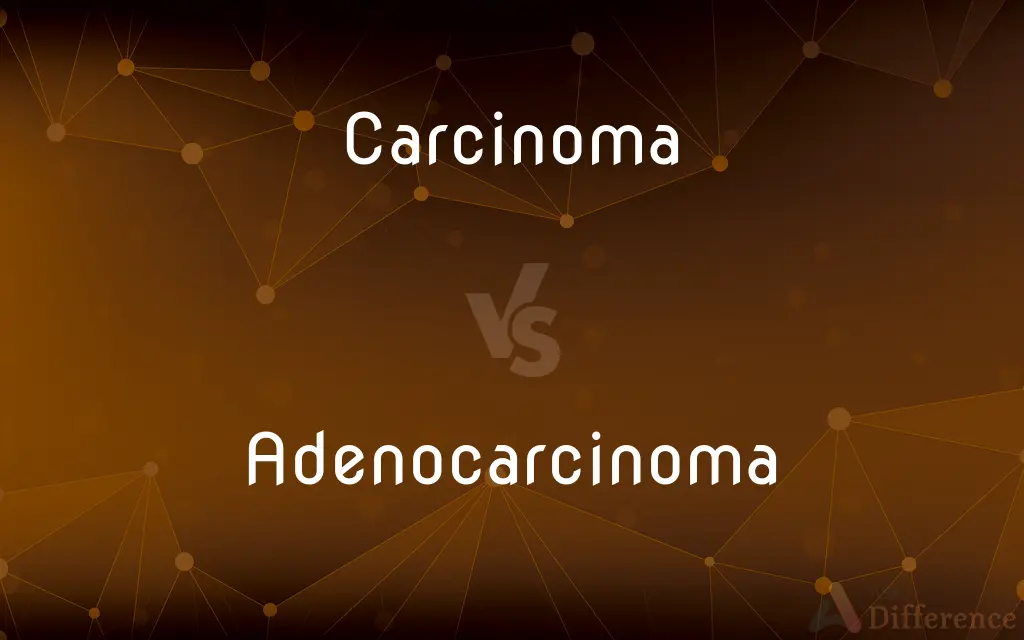Carcinoma vs. Adenocarcinoma — What's the Difference?
By Maham Liaqat & Urooj Arif — Updated on March 27, 2024
Carcinoma is a type of cancer that starts in the skin or tissue lining organs, while adenocarcinoma is a subtype of carcinoma that arises in glandular tissue.

Difference Between Carcinoma and Adenocarcinoma
Table of Contents
ADVERTISEMENT
Key Differences
Carcinoma encompasses a broad category of cancers originating in epithelial cells, which make up the skin and tissues lining or covering internal organs. It is one of the most common types of cancer and can appear almost anywhere in the body, including the lungs, colon, and prostate. Adenocarcinoma, on the other hand, is a specific type of carcinoma that begins in the glandular epithelial cells, responsible for secreting substances in various parts of the body, such as mucus, digestive juices, and other fluids.
Carcinomas, including adenocarcinomas, primarily affect adults and are characterized by their ability to spread to other parts of the body (metastasize). While carcinomas can manifest with a variety of symptoms depending on their location, adenocarcinomas often present symptoms related to the dysfunction of the glandular tissue from which they arise. For example, adenocarcinoma in the lungs may lead to breathing difficulties, while in the colon, it may cause changes in bowel habits.
The treatment for carcinomas generally involves a combination of surgery, radiation therapy, and chemotherapy. The treatment plan for adenocarcinomas might also include targeted therapy or immunotherapy, especially if the cancer has specific mutations that make it susceptible to these treatments. The choice of treatment depends on the cancer's type, stage, and location, as well as the patient's overall health.
Risk factors for developing carcinoma include tobacco use, excessive sun exposure, exposure to carcinogens, and certain genetic predispositions. Adenocarcinoma's risk factors similarly include lifestyle and environmental factors, but they may also be influenced by chronic conditions affecting glandular tissues, such as Barrett's esophagus for esophageal adenocarcinoma.
Diagnosis of carcinoma and adenocarcinoma involves a combination of physical exams, imaging tests, and biopsy procedures. The biopsy, where a sample of the tumor is examined under a microscope, is crucial for determining the cancer's type, including distinguishing adenocarcinoma from other forms of carcinoma.
ADVERTISEMENT
Comparison Chart
Origin
Starts in epithelial cells lining skin or internal organs.
Begins in glandular epithelial cells secreting substances.
Common Locations
Skin, lungs, chest, colon, prostate.
Glands of colon, lungs, prostate, chest.
Symptoms
Vary by location; can include lumps, skin changes, or pain.
Related to gland dysfunction; may cause obstruction or pain.
Treatment
Surgery, radiation, chemotherapy.
May include targeted therapy or immunotherapy.
Risk Factors
Tobacco, sun exposure, carcinogens, genetics.
Lifestyle, environmental factors, chronic glandular conditions.
Compare with Definitions
Carcinoma
Broad category of cancer.
Squamous cell carcinoma affects the outer layers of skin and mucous membranes.
Adenocarcinoma
Glandular cancer subtype.
Pancreatic cancer is often adenocarcinoma, originating in the glandular tissue.
Carcinoma
Epithelial origin.
Renal cell carcinoma arises from the lining of the kidney tubules.
Adenocarcinoma
Specific to secreting cells.
Adenocarcinoma in the chest often begins in the milk ducts.
Carcinoma
Treatable through multiple methods.
Early-stage carcinoma may be treated successfully with surgery.
Adenocarcinoma
Associated with specific risk factors.
Gastroesophageal reflux disease increases the risk of esophageal adenocarcinoma.
Carcinoma
Varied symptoms.
Carcinoma of the skin may present as a non-healing ulcer or changing mole.
Adenocarcinoma
May require specialized treatment.
Certain adenocarcinomas are treated with hormone therapy.
Carcinoma
Common and widespread.
Carcinoma accounts for the majority of lung cancer cases.
Adenocarcinoma
Diagnosed through biopsy.
A biopsy confirming adenocarcinoma will show cancerous glandular cells.
Carcinoma
Carcinoma is a malignancy that develops from epithelial cells. Specifically, a carcinoma is a cancer that begins in a tissue that lines the inner or outer surfaces of the body, and that arises from cells originating in the endodermal, mesodermal or ectodermal germ layer during embryogenesis.Carcinomas occur when the DNA of a cell is damaged or altered and the cell begins to grow uncontrollably and become malignant.
Adenocarcinoma
Adenocarcinoma (; plural adenocarcinomas or adenocarcinomata ) (AC) is a type of cancerous tumor that can occur in several parts of the body. It is defined as neoplasia of epithelial tissue that has glandular origin, glandular characteristics, or both.
Carcinoma
An invasive malignant tumor derived from epithelial tissue that tends to metastasize to other areas of the body.
Adenocarcinoma
A malignant tumor originating in glandular tissue.
Carcinoma
(countable) An invasive malignant tumour derived from epithelial tissue that tends to metastasize to other areas of the body.
Adenocarcinoma
(oncology) Any of several forms of carcinoma that originate in glandular tissue.
Carcinoma
A form of cancer; (uncountable) cancer in general as a disease.
Adenocarcinoma
Malignant tumor originating in glandular epithelium
Carcinoma
A form of malignant cancer arising from epithelial tissue. The term was earlier applied to all forms of cancer, or to certain non-malignant forms. It is contrasted with sarcoma, a malignant form of cancer arising from connective tissue. See Cancer.
Carcinoma
Any malignant tumor derived from epithelial tissue; one of the four major types of cancer
Common Curiosities
What makes adenocarcinoma different from other carcinomas?
Adenocarcinoma specifically arises from glandular tissue, while other carcinomas originate from different types of epithelial cells.
How common is adenocarcinoma compared to other types of cancer?
Adenocarcinoma is one of the most common cancer types, especially in cases involving the lungs, colon, and chest.
What are the survival rates for adenocarcinoma?
Survival rates vary widely based on the cancer's stage, location, and how well it responds to treatment. Generally, early-stage adenocarcinomas have a better prognosis.
Is chemotherapy effective against adenocarcinoma?
Chemotherapy can be effective, particularly in combination with other treatments like surgery and radiation, depending on the cancer's specific characteristics and stage.
Can adenocarcinoma be cured?
Like other cancers, the curability of adenocarcinoma depends on its stage at diagnosis, location, and the patient's overall health. Early detection significantly improves the chances of successful treatment.
How is adenocarcinoma detected?
It is often detected through imaging tests (e.g., CT scans, MRIs) followed by a biopsy to examine the cell type under a microscope.
Are there any preventative measures for adenocarcinoma?
Preventative measures include avoiding known risk factors like smoking, managing chronic conditions that may lead to glandular cell changes, and regular screening for at-risk individuals.
What role do genetics play in the risk of developing adenocarcinoma?
Genetics can play a significant role, especially in cancers like chest adenocarcinoma, where mutations in genes like BRCA1 and BRCA2 increase risk.
How does adenocarcinoma spread?
Like other cancers, adenocarcinoma can spread through the body via the lymphatic system or bloodstream, leading to metastasis in other organs.
Can lifestyle changes reduce the risk of developing adenocarcinoma?
Yes, lifestyle changes such as quitting smoking, maintaining a healthy weight, and reducing alcohol consumption can lower the risk of developing many types of adenocarcinoma.
Share Your Discovery

Previous Comparison
Recrystallization vs. Crystallization
Next Comparison
Clarify vs. ConfirmAuthor Spotlight
Written by
Maham LiaqatCo-written by
Urooj ArifUrooj is a skilled content writer at Ask Difference, known for her exceptional ability to simplify complex topics into engaging and informative content. With a passion for research and a flair for clear, concise writing, she consistently delivers articles that resonate with our diverse audience.














































